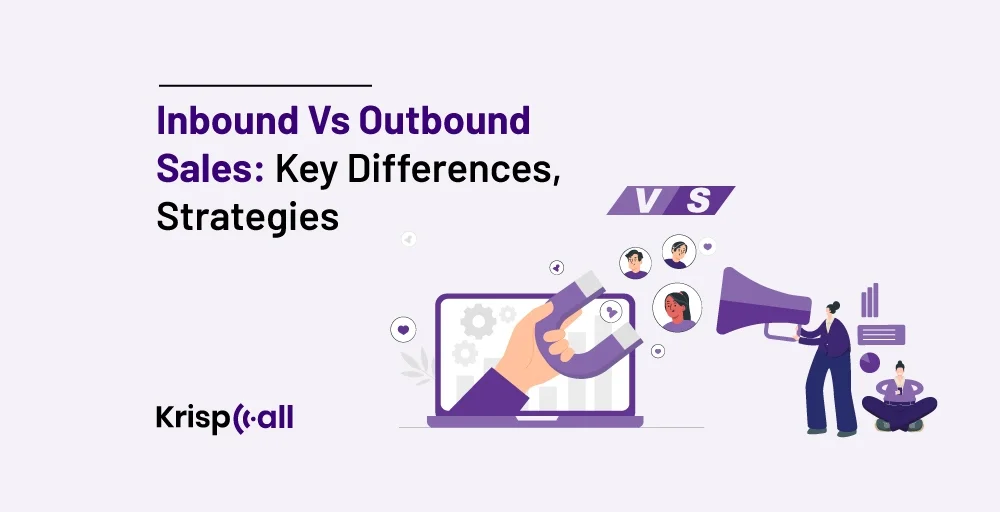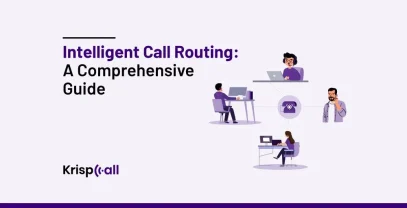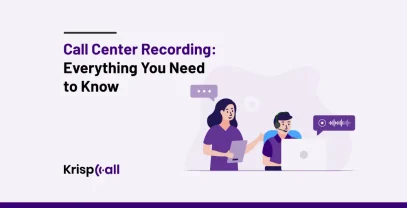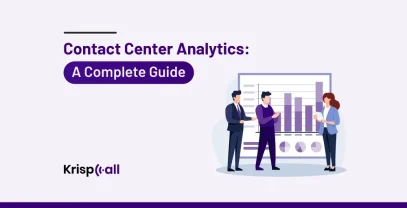Are you having a hard time figuring out the best sales approach for your company? Or you might be wondering if you should focus on inbound or outbound sales or take a hybrid approach to use both strategies.
Even though it is beneficial to focus on both inbound and outbound sales, you must know when to select the correct approach and exactly how to proceed.
Finding the perfect sales strategy can be challenging, but it’s an important decision that will shape your company’s success. This article will help you decide.
🔑 KEY HIGHLIGHTS
- Inbound sales are when a business focuses on drawing customers’ attention rather than approaching them first.
- Outbound sales are when a company initiates the conversation through methods like cold calling or cold emailing.
- If your company is customer-centric and focuses on building customer connections, then inbound sales can be the best tool for you.
- If your business is product-centric, then outbound sales can be the best choice for you.
- You can use both ways to grow your sales as much as possible.
What are inbound sales?
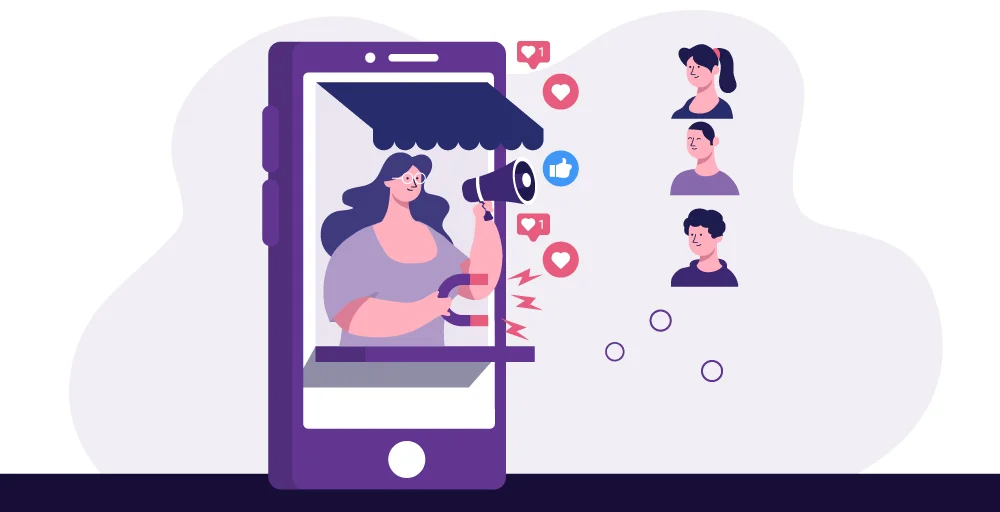
Inbound sales are a strategy that focuses on creating content for a targeted customer to satisfy the needs and alleviate the pain points of a target customer.
For example, if you have a clothing business, you will create content about your clothing line and post it on a popular platform like TikTok or Instagram. If a customer wants to buy a shirt for an event, they will search for it on the find your page and then contact you. This is what an inbound sale is all about.
The company doesn’t have to chase every customer. Instead, it can take control by creating content and posting it on various platforms. This way, the customer is drawn to the company first.
Key elements of an effective inbound sales strategy
Now that we have learned about inbound sales, we might still be confused about what are the elements that make inbound sales so effective.
There are some key elements that will help a business make incredible inbound sales effectively.
1. Search engine optimization (SEO)
SEO is a crucial part of inbound sales. It optimizes your webpage and creates traffic on the search engine results page (SERP). It is an organic method of earning your website/webpage rank on Google. This allows you to have a high traffic and relevant audience on your website.
2. Content marketing
Content marketing plays a pivotal role in the inbound sales strategy. By providing valuable content and information, businesses can draw customers to their websites. In fact, according to HubSpot, over 53% of marketers consider content marketing a top priority in inbound sales. This strategy not only attracts customers but also enhances brand visibility.
3. Social media marketing
Today, social media provides a platform to engage with your customers. A total of 62.3% of the global population uses social media. On average, users spend 2 hours and 23 minutes a day on these platforms. Hence, many businesses now use social media marketing strategies, especially inbound sales, to enhance sales and connect with customers.
4. Pay-per-click (PPC) marketing
PPC is a tool or tactic that falls under inbound sales. It is a paid marketing tool, as you have to pay Google to rank your website on the first search page. With PPC, you can find your target customer and adjust your budget.
What are outbound sales?

Outbound sales is a method of reaching customers through cold calling, email, and other process. In outbound sales, messages are sent, customers are called, and they are informed about the product or service the business provides. This sale aims to connect with potential clients and get them interested in your product.
Outbound marketing is also known as a traditional sales method. In this method, you do not wait for a customer to find you. Instead, you take the first step by reaching out to potential customers through various methods.
For example, let’s say you sell handmade soaps. An outbound sales example could be reaching out to local spas and salons to introduce your products through emails and cold calls. You explain the benefits of your soaps and offer them samples to try. This way, you’re actively reaching out to potential customers who may be interested in your product.
Strategies to enhance outbound sales
When you’re trying to sell something to people who don’t know about your product, it’s important to plan carefully. Follow these strategies to reach your targeted audience and enhance outbound sales:
1. Identify your audience
To enhance outbound sales, companies should be able to identify those customers who are likely to buy the stuff. For example, if you sell toys, your target audience will automatically be children. Figuring out your targeted audience is the first step in outbound sales.
2. Engage in cold calling
Cold calling is one of the most effective outbound sales strategies. It allows businesses to make quick and personal connections with customers and even receive immediate feedback about their product during the call.
3. Send cold emails
Cold emails target potential customers and promote the product or service through an email communication platform. A business can create quality emails with various subject lines or opening statements to capture customers’ attention.
4. Collect information from social media
Another strategy in outbound sales is using social media platforms to collect potential customers’ insights. With social media, businesses can observe various interactions and gain valuable information, which can help them improve their sales.
Inbound vs outbound sales: What is the difference?
Inbound sales and outbound sales are two ways to get customers. In inbound sales, prospects find business, whereas in outbound sales, businesses find prospects.
Here is how they are different.
| Inbound Sales | Outbound Sales |
| Inbound sales focuses on drawing customers’ attention rather than approaching them first. | In outbound sales, agents approach the customer first through cold calling, email, and other methods. |
| Inbound use SEO, content writing, PPC marketing, and social media marketing to increase sales. | Outbound sales uses cold calling, messaging, and emailing to increase sales. |
| Inbound sales are customer-centric. | Outbound sales are business and product-centric. |
| Inbound sales are cost-effective, have higher lead quality, and brand recognition. | Outbound sales are more expensive as they have a higher outreach and more targeted customers. |
| It is two-way communication and is more engaged than outbound sales. | It is one-way communication and is less engaged than inbound sales. |
Inbound vs outbound sales: The sales process
Even though the ultimate goal of inbound and outbound sales is to increase sales, they use different ideas and techniques. Let’s take a look at how inbound and outbound sales work.
Inbound sales process
An inbound sales process is a method of grabbing the attention of customers, keeping them engaged, and turning them into buyers. Here’s how it works, step-by-step.
1. Identify the customers
Identifying the customer is the first step for any sales company. Inbound sales targets those who are searching for a solution to their problem. You can identify customers through a blog post, different forms filled by customers, and their chat with chatbots.
2. Connect with the customer
After identifying your potential customer, you need to connect with the customer so that you can identify whether a customer is a potential lead or not. In this process, sales representatives review the gathered information and qualify the buyer by asking sales qualifying questions.
3. Explore customer problem
Exploring allows sales to evaluate the customer’s problem, like how the service can help them, and, more importantly, the compatibility between a lead’s needs and their product. After measuring these approaches, inbound salespersons can solve the customer’s issue more deeply and effectively, increasing the success of the sale.
4. Give solution to the problem
Finally, inbound sales focus on providing the solution for the problem rather than forcing them to buy the product. Sales reps advise customers with the best solution they provide for them and demonstrate how their service actually helps them. In this phase, your main motive is to convert potential leads into paying customers.
Outbound sales process
In outbound sales, the sales rep has to reach out to their customer so that they can demonstrate their service and product to the customer. So, to do that, the company has to go through some process. Here are step-by-step process;
1. Identify your potential customer
The first and crucial step in outbound sales is identifying the potential customer. While identifying the customer, you need to consider who needs what you’re selling and who you will sell to. After that, examine your existing customers, create their common data, and gather their purchase history.
2. Generate leads
Now that you have identified your customer, it’s time to think about how you will get their information. To get that information, you can either contact the in-house lead generation team or buy a database from third-party companies like LinkedIn or social media platforms like Facebook or Twitter.
3. Qualify and contact the potential leads
After identifying the customer and finding a way to contact them, the company now has to determine whether they are the right customers for your services or products. If they’re interested, you can move them to the next step; if not, you can remove them from the list.
4. Sales call
Finally, you have now identified the customer and qualified the potential lead. It’s high time to present how a product or service works and how your service can solve their specific problems or meet their needs. This process can involve a personal meeting or a cold call method.
5. Closing the deal
Once your sales and demos successfully convert the client into a paying customer, your company can finally close the deal. However, even after closing the deal, a company can follow up on the sales to continue providing value and building trust.
Inbound vs outbound sales: When to use each?
Inbound and outbound sales are two different ideas that businesses use to increase their sales. In inbound sales, the customer reaches out to the company asking about the service or product. On the contrary, for inbound sales, businesses have to reach out to customers to inform them about the product and service the company provides.
A company can choose both strategies to increase sales. However, as inbound and outbound use different approaches to sales, a business needs to have a clear picture while selecting these sales tools.
For example, if your company is well-known and sells popular stuff, your company can use inbound sales approaches. However, if your company offers different and new things, then you need to use the outbound sales technique.
Similarly, if your company is customer-centric and focuses on building customer connections, then inbound sales can be the best tool for you. Inbound sales focus on creating valuable content that addresses the needs and interests of the audience.
On the other hand, if your business is product-centric, then outbound sales can be the best choice for you, as it reaches out to people via cold calls, emails, or social media and can bring rapid results.
Inbound vs outbound sales: Pros and cons
✔️ Pros of inbound sales
- Customer-centric sales
- Cost-efficient than outbound sales
- Better brand recognition
- High scalability
❌ Cons of inbound sales
- Requires a lot of resources.
- Less predictable
- Highly competitive
- Need massive time commitment
✔️ Pros of outbound sales
- Provide faster result
- More predictable than inbound sales
- Wider audience reach
- Easily automate a large portion of outbound sales
❌ Cons of outbound sales
- Less engaged
- Difficult for startups
- More expensive than inbound
- Time-consuming
Final Thoughts
Both inbound and outbound sales have their own method of increasing sales processes and plans. While Inbound sales bring customers to your business through methods like SEO, content marketing, and social media, outbound sales involve reaching out to possible customers through cold calling, messaging, and emailing.
Both methods have advantages and work best for different businesses. Inbound sales focus more on the customer, cost less money, and can grow. Outbound sales get faster results, and you can reach more people. The choice depends on your business, customers, and sales goals. You can use both ways to grow your sales as much as possible.
FAQ
What is inbound vs outbound example?
Inbound sales focus on creating and distributing content from websites, social media, and blogs to draw people’s attention while outbound sales focus on marketing that requires reaching out to customers through cold calling, emails, and ads.
Is inbound sales cold calling?
No, Inbound sales aren’t cold calling. Instead, customers themself call the company demanding the product or service.
Which is better: outbound or inbound sales?
Whether outbound sales or inbound sales is better depends on your company goals, sales process, and target audience. If your business aims to provide better customer service, then inbound marketing is the approach you should choose. If your business is product-centric, then you should choose outbound sales as it offers a stronger return on investment.

